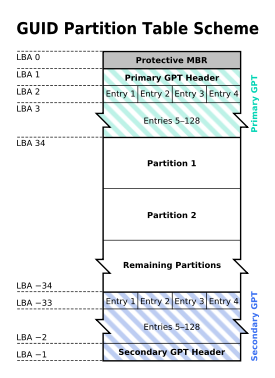by cyberciti.biz
Frankly speaking, you cannot create a Linux partition larger than 2 TB using the fdisk command. The fdisk won’t create partitions larger than 2 TB. This is fine for desktop and laptop users, but on server you need a large partition. For example, you cannot create 3TB or 4TB partition size (RAID based) using the fdisk command. It will not allow you to create a partition that is greater than 2TB. In this tutorial, you will learn more about creating Linux filesystems greater than 2 Terabytes to support enterprise grade operation under any Linux distribution.
To solve this problem use GNU parted command with GPT. It supports Intel EFI/GPT partition tables. Partition Table (GPT) is a standard for the layout of the partition table on a physical hard disk. It is a part of the Extensible Firmware Interface (EFI) standard proposed by Intel as a replacement for the outdated PC BIOS, one of the few remaining relics of the original IBM PC. EFI uses GPT where BIOS uses a Master Boot Record (MBR).

(Fig.01: Diagram illustrating the layout of the GUID Partition Table scheme. Each logical block (LBA) is 512 bytes in size. LBA addresses that are negative indicate position from the end of the volume, with -1 being the last addressable block. Imaged Credit Wikipedia)
Linux GPT Kernel Support
EFI GUID Partition support works on both 32bit and 64bit platforms. You must include GPT support in kernel in order to use GPT. If you don’t include GPT support in Linux kernelt, after rebooting the server, the file system will no longer be mountable or the GPT table will get corrupted. By default Redhat Enterprise Linux / CentOS comes with GPT kernel support. However, if you are using Debian or Ubuntu Linux, you need to recompile the kernel. SetCONFIG_EFI_PARTITION to y to compile this feature.
File Systems
Partition Types
[*] Advanced partition selection
[*] EFI GUID Partition support (NEW)
....Find Out Current Disk Size
Type the following command:
# fdisk -l /dev/sdb
Sample outputs:
Disk /dev/sdb: 3000.6 GB, 3000592982016 bytes
255 heads, 63 sectors/track, 364801 cylinders
Units = cylinders of 16065 * 512 = 8225280 bytes
Sector size (logical/physical): 512 bytes / 512 bytes
I/O size (minimum/optimal): 512 bytes / 512 bytes
Disk identifier: 0x00000000
Disk /dev/sdb doesn't contain a valid partition tableLinux Create 3TB partition size
To create a partition start GNU parted as follows:
# parted /dev/sdb
Output:
GNU Parted 2.3
Using /dev/sdb
Welcome to GNU Parted! Type 'help' to view a list of commands.
(parted)Creates a new GPT disklabel i.e. partition table:
(parted) mklabel gptSample outputs:
Warning: The existing disk label on /dev/sdb will be destroyed and all data on this disk will be lost. Do you want to continue?
Yes/No? yes
(parted)Next, set the default unit to TB, enter:
(parted) unit TBTo create a 3TB partition size, enter:
(parted) mkpart primary 0 0OR
(parted) mkpart primary 0.00TB 3.00TBTo print the current partitions, enter:
(parted) printSample outputs:
Model: ATA ST33000651AS (scsi)
Disk /dev/sdb: 3.00TB
Sector size (logical/physical): 512B/512B
Partition Table: gpt
Number Start End Size File system Name Flags
1 0.00TB 3.00TB 3.00TB ext4 primaryQuit and save the changes, enter:
(parted) quitSample outputs:
Information: You may need to update /etc/fstab.Use the mkfs.ext3 or mkfs.ext4 command to format the file system, enter:
# mkfs.ext3 /dev/sdb1
OR
# mkfs.ext4 /dev/sdb1
Sample outputs:
mkfs.ext4 /dev/sdb1
mke2fs 1.41.12 (17-May-2010)
Filesystem label=
OS type: Linux
Block size=4096 (log=2)
Fragment size=4096 (log=2)
Stride=0 blocks, Stripe width=0 blocks
183148544 inodes, 732566272 blocks
36628313 blocks (5.00%) reserved for the super user
First data block=0
Maximum filesystem blocks=4294967296
22357 block groups
32768 blocks per group, 32768 fragments per group
8192 inodes per group
Superblock backups stored on blocks:
32768, 98304, 163840, 229376, 294912, 819200, 884736, 1605632, 2654208,
4096000, 7962624, 11239424, 20480000, 23887872, 71663616, 78675968,
102400000, 214990848, 512000000, 550731776, 644972544
Writing inode tables: done
Creating journal (32768 blocks): done
Writing superblocks and filesystem accounting information: done
This filesystem will be automatically checked every 31 mounts or
180 days, whichever comes first. Use tune2fs -c or -i to override.
Type the following commands to mount /dev/sdb1, enter:
# mkdir /data
# mount /dev/sdb1 /data
# df -H
Sample outputs:
Filesystem Size Used Avail Use% Mounted on
/dev/sdc1 16G 819M 14G 6% /
tmpfs 1.6G 0 1.6G 0% /lib/init/rw
udev 1.6G 123k 1.6G 1% /dev
tmpfs 1.6G 0 1.6G 0% /dev/shm
/dev/sdb1 3.0T 211M 2.9T 1% /data
Make sure you replace /dev/sdb1 with actual RAID or Disk name or Block Ethernet device such as /dev/etherd/e0.0. Do not forget to update /etc/fstab, if necessary. Also note that booting from a GPT volume requires support in your BIOS / firmware. This is not supported on non-EFI platforms. I suggest you boot server from another disk such as IDE / SATA / SSD disk and store data on /data.